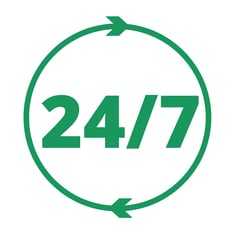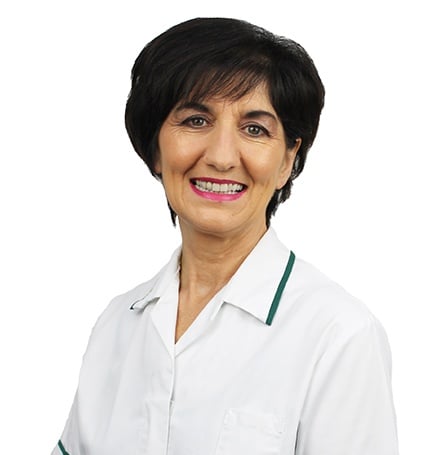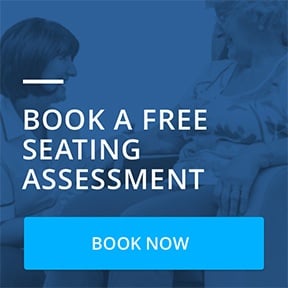In the past, it’s been common practice to focus on the bed and the mattress for someone suffering from a pressure injury. For this reason, clinical research, technology and practice has become highly developed in these areas. As a result, patients suffering from pressure injuries are primarily nursed in bed.*
REQUEST A FREE COPY OF THE CLINICIAN'S SEATING HANDBOOK
Imagine being in bed for a prolonged period of time hours, days, weeks, maybe even months or years. This can have a significant affect on a person cognitively, psychologically, physically and socially.
Minor tasks like reading, writing and eating food is more challenging. Physically complications can include contractures, muscle atrophy, urinary tract infections, pneumonia, anorexia, constipation and bowel impaction.
Other complications of bedrest include depression, learned helplessness, perceptual changes and fatigue. Available literature does not contain evidence supporting the use of bedrest to facilitate healing of pressure ulcers.1
Early Mobilization
Today early mobilization is seen as an important aspect of a person's rehabilitation. The prescription of clinical seating can help aid in recovery by supporting a patient to get out of bed earlier. As a result, patients can experience less muscle atrophy, increased strength and conditioning. On top of this, it can help reduce a patient's hospital stay and increase patient flow.
It’s been suggested that 95% of all pressure injuries are completely avoidable. Evidence indicates that bedrest may not be the sole form of prevention. When therapeutic setting is correctly prescribed, there is much improvement in a patient’s functioning to aid recovery and improve their health.2 Physiologically, a person is able to swallow, digest food and eliminate in a seated posture, much more so than if lying in bed. In addition, improved posture can increase respiration with oxygen levels recorded as higher in users seated in a therapeutic seat as opposed to a standard chair.3
Good sitting posture can facilitate a better quality of life, improve a person's social interaction and self image, giving significant psychological benefits. Sitting upright can also help improve a person's functional ability for simple tasks like eating and drinking, which will aid nutrition, hydration, and productivity.**
A 24 hour package of care
 Lack of therapeutic seating for daytime use could be counterproductive for patients on a pressure management system for supine sitting. The existence of evidenced-based clinical seating would allow healing to occur no matter if a patient is in bed or chair. Thus therapeutic seating could be seen as a compliment to the use of therapeutic beds and mattresses as is also allows for prevention, treatment and healing to continue while seated.
Lack of therapeutic seating for daytime use could be counterproductive for patients on a pressure management system for supine sitting. The existence of evidenced-based clinical seating would allow healing to occur no matter if a patient is in bed or chair. Thus therapeutic seating could be seen as a compliment to the use of therapeutic beds and mattresses as is also allows for prevention, treatment and healing to continue while seated.
What does this mean for you?
If you're reading this and wondering how clinical, therapeutic seating can help improve patient outcomes in your facility, please contact us.
- Norton, L., & Sibbald, G. (2004). Is bedrest an effective treatment modality for pressure ulcers? Ostomy Wound Management, 50 (19), 40-51
- Sonenblum, S.E., Sprigle. S.H., (2011). The impact of tilting on blood flow and localized tissue loading. Journal of Tissue Viability, 20(1), 3-13.
- Caser, J., & Grittins, L. (2013). Use of tilt-in-space in seating systems for adults with physical disabilities. Physical Therapy Reviews, 18 (4), 2 85-299.
*Note - the purpose of this blog is to give an overview of the product with some tips to consider on its use. This is not intended to be a substitute for professional or medical advice, diagnosis, prescription or treatment and does not constitute medical or other professional advice. For advice with your personal health or that of someone in your care, consult your doctor or appropriate medical professional.
** These results should not be interpreted as a predictor or guarantee of future financial or clinical outcomes with different patients. Clinicians and users must employ correct decision making, undertake proper assessments, education, comply with local regulations and ensure correct use of equipment. The resulting report from this randomized control trial shows that the study consisted of 38 participants from 3 nursing home settings, who were randomly assigned to control and intervention groups using computer-generated numbers. The study’s results in regard to pressure ulcers has been calculated from the change in pressure ulcers/pressure injuries/skin redness in both the intervention and control group. As a pilot study of a specific nature, it was not blinded. The measurement of pressure ulcers was observational and the analysis of the results included various forms, not including statistical analysis. The study has been reviewed and presented at over 30 academic conferences in 3 continents and is pending publication in a respected peer-reviewed journal.






